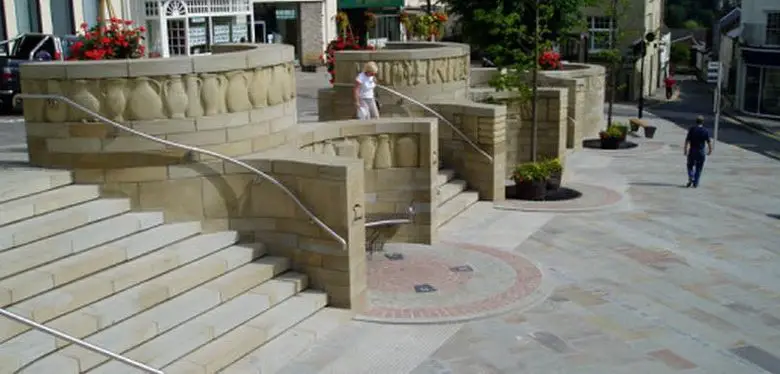
Inaccessible high streets: challenging the retailers
Following on from Fleur Perry’s article last week, demanding that retailers listen up and tackle the accessibility issues on our high street, it was time for her to take action and challenge one particular store on her local high street with an inexcusable accessibility issue. Here’s how it went down…!
Starting my challenge with a rather delicious hot chocolate in the library (whoever decided libraries needed cafes has my eternal gratitude), I headed for the main street to look for the big name retailers and saw something that had been staring me in the face for more than 20 years: a nightmare bank with a step five inches high and ten feet wide – no ramp.
Now, I’ve not studied journalism or PR, so I’m going to use a trick used by comedians (and they never get into trouble!) and refer to this particular bank as Boyds. This branch of Boyds has been in the same building for as long as I remember, with the same step and the same half-hearted nods to the DDA. This branch used to be responsible for a bone-shaking bump on a regular basis going up and down that step in a manual wheelchair, and it has had 19 years to do something about this, yet hasn’t. This branch of Boyds was going to be asked why.
Given the access arrangements, this was easier said than done. It took 20 minutes for my carer to get anyone down to see me, where I waited patiently outside in the seldom-seen sun. As I sat there, I watched the passers-by and I saw that an awful lot of Boyds’ customers saw the step not as barrier, but as a hurdle to be overcome without question.
I saw mums struggling with buggies and elderly people painful climbing the step. The accessibility of high streets is undoubtedly a disability rights issue, but it goes much wider than that. A women in her eighties almost stumbled down that step that day.
The step, though inexcusable, is not the only problem with that branch. There’s a call for assistance button… on the inside of the branch. There are steep escalators up to, well, I don’t know what, but it’s where most of the transactions take place. There’s no lift.
It would be so, so easy for Boyds to make things right. A £20 doorbell, a £50 portable ramp and a door knocked through from the first floor of the shopping centre behind, say, £200 maybe. I wonder how much their advertising budget is annually…
Eventually, someone did come down to speak to me. I said I was interested in opening a current account – yes today please, and no, I can’t go to the other branch two miles away. Of course, there was absolutely no way for them to do this.
Though the Boyds employee was extremely polite and apologised again and again, I was essentially refused service. When I asked the Boyds employee why the step was still here, why it wasn’t sorted out years ago, the reply attempted to pass the buck on to the local council. Apparently, the council had refused to approve a move to another unit recently.
Tea was needed to process this information, so I made a few notes in a cafe just round the corner. Chance had chosen me a table by the window, so I began counting. In 15 minutes, I counted 59 people I thought would have found Boyds inconvenient or impossible.
Given this was a side street, I trebled it to get the number passing Boyds who could have found it inconvenient or impossible. Then, multiplying by eight to account for a teo hour lunch rush and multiplying by five days in a working week, I estimate that Boyds are inconveniencing and excluding at least 7,000 customers in working lunchbreaks.*
I’m certain that at some point in the last 19 years Boyds would have had an opportunity to move. Surely they could have found £50 for a ramp, perhaps when the economy was more stable. Nay, Boyds just need to get off their high horse.
*This figure is an underestimate. It doesn’t include people with invisible impairments, it only covers part of the day, and does not include weekends.
But it’s not just banks that have an issue, and it’s not just the outsides of the buildings. So, if I were a retailer, here are some really easy ways to make a difference:
Make sure racks and rails are spaced far enough apart. As a general rule of thumb, if you can’t catwalk strut around your shop floor with your hands on your hips like a diva, something needs to move.
Clean as you go. Never leave step-stools, shop trolleys or boxes on the shop floor unless you’re using them there and then.
Don’t put breakable objects on low shelves or near the edges of tables. There are few more nerve-racking experiences than driving a wheelchair around a kitchenware department, trying not to be the proverbial bull in the china shop.
Check what you’ve already got in place. Make sure disabled toilets and changing rooms aren’t being used as storage areas. If you need a particular key to open them, make sure everyone knows where it’s kept. Check that lifts, induction loops and any other bits and bobs are in good working order.
Talk to people. If you see somebody struggling or looking stressed, don’t be afraid to ask if you can help. You’ll either get a positive response or an “I’m fine, thank you”.
Read Trailblazer’s full report on inaccessible high streets, and find out how you can make a difference.
By Fleur Perry
Check out…
• My disability shopping list
• Disability and parenting: how possible is it?
• The great mobility scooter debate/
Join in the latest hot disability debates by messaging us on Facebook, tweeting us @DHorizons, emailing us at editor@disabilityhorizons.com or leaving your comments below.